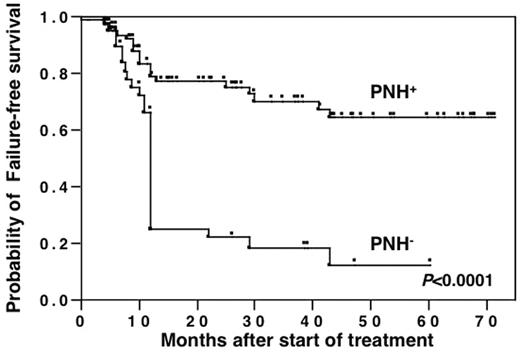Abstract
To determine the clinical significance of a minor population of glycosylphosphatidylinositol-anchored membrane protein-negative (GPI-AP−) cells in acquired aplastic anemia (AA), we quantified CD55− CD59− granulocytes and red blood cells (RBCs) in peripheral blood from 122 patients with recently diagnosed AA and correlated numbers of GPI-AP− cells and responses to immunosuppressive therapy (IST). The highly sensitive flow cytometry detected 0.005% to 23.1% of GPI-AP− cells in 68.0% of AA patients. Sixty-eight of 83 (91%) patients with an increased ratio of GPI-AP− cells (PNH+) responded to antithymocyte globulin (ATG) + cyclosporin (CsA) therapy, whereas 18 of 39 (48%) without such an increase (PNH−) responded. Failure-free survival rates were significantly higher (64%) among PNH+ than PNH− patients (12%) at 5 years (Figure) although overall survival rates were comparable between the groups. Numbers of GPI-AP− and GPI-AP+ cells increased in parallel among most PNH+ patients who responded to IST, suggesting that these cells are equally sensitive to immune attack. These results indicate that a minor population of GPI-AP− cells represents a reliable marker of a positive IST response and a favorable prognosis among patients with AA. Furthermore, immune attack against hematopoietic stem cells that allows PNH clonal expansion might occur only at the onset of AA.
Author notes
Corresponding author


This feature is available to Subscribers Only
Sign In or Create an Account Close Modal